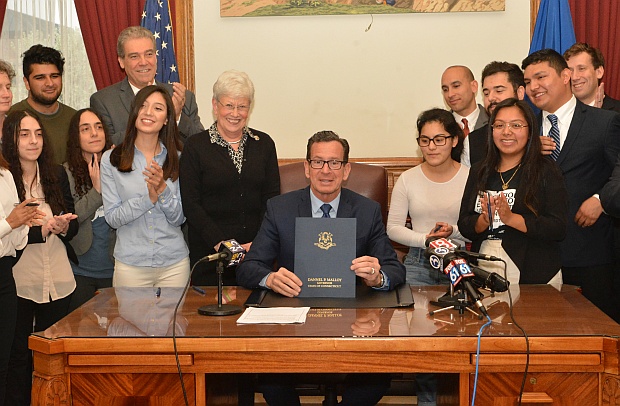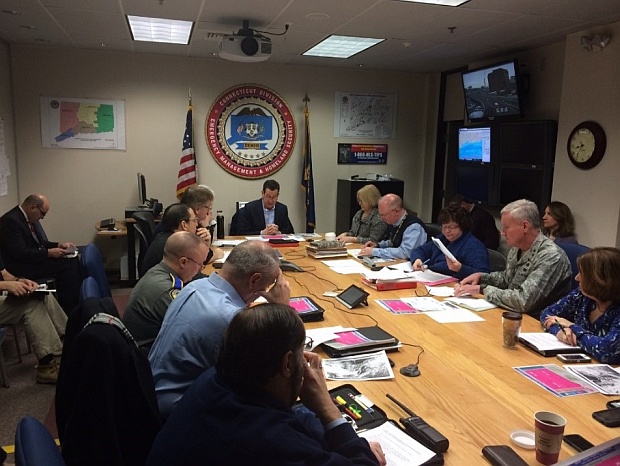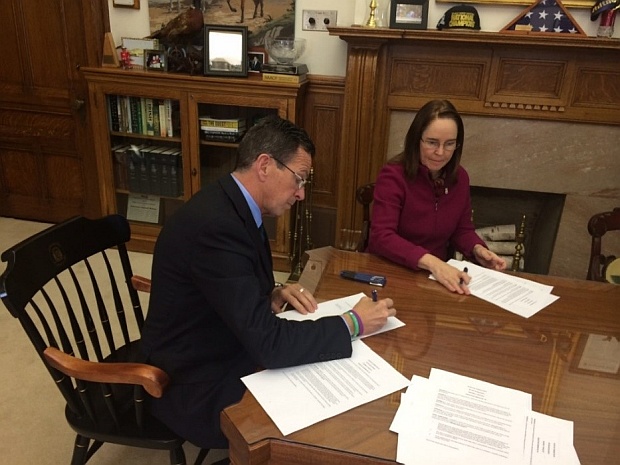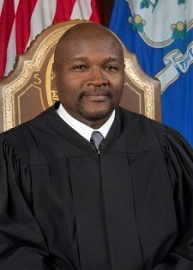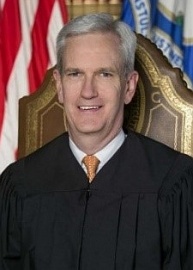|
“This is good public policy and specifically, good public health. Why would you want to eat food from a sick restaurant cook? Or have your children taken care of by a sick day care worker? The simple answer is — you wouldn’t. And now, you won’t have to.”
—Governor Dannel P. Malloy on final passage of paid sick leave law, June 4, 2011
|
Even after the Great Recession, the economic gap between the rich and working poor continues to grow while many historically marginalized groups continue to be subject to harassment, oppression and unequal treatment in the workplace. Through his tenure, the Governor fought tirelessly to improve fairness in the workplace by promoting safer working conditions, mandating critical employee protections, closing the gender wage gap, lifting low wage workers out of poverty and providing formerly incarcerated people with a true second chance by removing barriers to employment. Many of these initiatives became the rallying cry for fairness across the country as other states followed Connecticut’s lead.
Progress during the Malloy administration
Employees should not face the choice of going to work sick or losing their job. Parents should not have to risk losing a paycheck to care for their sick children. Colleagues should not have to risk exposing their coworkers to illness because they risk being fired. Employees who come to work while sick can unintentionally spread germs to their coworkers and customers, spreading illness further. Employees who are not offered paid sick leave by their employer tend to delay medical care, which could lead to more complications, expensive health care, and more days out of work.
Therefore, guaranteeing service workers access to paid sick leave was one of Governor Malloy’s top priorities during his inaugural year. Specifically, legislation focused on ensuring workers in food service, hospitality, and healthcare occupations had access to paid sick time in order to prevent them from spreading illnesses to their colleagues and clients.
Connecticut’s paid sick leave law Guarantees roughly 500,000 employees sick time who previously had none. The Connecticut model allows employees to earn one hour of sick time for every 40 hours worked, capped at 40 hours per year. Eligible employees include service workers paid on an hourly basis in businesses with 50 or more employees.
A year-and-a-half after implementation, the Center for Economic and Policy Research surveyed employers and many reported improvements in morale and office health, and few employers found abuse of the law. In fact, three quarters expressed support for the policy.[116]
Out of Connecticut’s workforce of 1.7 million people, there are an estimated 70,000 to 90,000 workers who earn the minimum wage. Governor Malloy steadfastly believed that no person working full-time should earn a paycheck below the poverty line. Particularly because most minimum wage workers are adults and 60 percent are women. Increasing minimum wage is one of the most effective ways to raise children and families out of poverty. When workers do not earn enough to cover their basic needs, they resort to public assistance to supplement the lack in wages, in turn leaving families in a perpetual cycle of poverty. A study by the University of California, Berkeley[117] found that 51 percent of New England State’s public assistance spending supported working families.
In 2012, Governor Malloy worked with Senator Looney and the General Assembly to increase the minimum wage for the first time in four years. By implementing the increase over a four-year period, the state provided predictability for the business community.
Upon full implementation in 2014, Connecticut became the first state in the nation to raise the minimum wage to $10.10. During the past six years, the annual earnings of a minimum wage worker increased by nearly $4,000 annually.
In 2018, women in Connecticut were paid 82 cents for every dollar paid to men.[118] The gap was greater for minority women; black women in Connecticut were paid 58 cents and Hispanic women were paid 47 cents for every dollar paid to white, non-Hispanic men in 2018.This wage gap affects women of all backgrounds, at every age and at all education levels. These lost wages mean women have less money to support themselves and their families.
In January 2013, Governor Malloy convened the Gender Wage Gap Task Force to study pay inequity and make recommendations to close wage gaps. Members of the group came from a range of backgrounds including public and private sector leaders, nonprofit advocacy, labor, and human resources. During its study, the task force collected data from the Connecticut Department of Labor, consulted national experts, and reviewed comprehensive studies from well-respected research institutions.
In its final report issued in November 2013, the task force made a number of recommendations to increase awareness, promote education, support working women, promote business best practices, and continue to monitor wage gaps.[119] In the years ahead, the administration introduced proposals to combat the wage gap.

Joined by young activists, state officials, and lawmakers, Governor Malloy signs legislation that strengthens Connecticut’s efforts to secure equal pay for equal work for women in the workplace and help prevent unintended wage discrimination. (May 22, 2018)
In 2015, the Governor led the passage of legislation to end "pay secrecy" – a practice among employers that frequently hinders pay discrimination from being pinpointed. It is now illegal for employers to prohibit their employees from disclosing their own compensation information or inquiring about the wages of another employee. Furthermore, in 2018 additional legislation to prohibit employers from inquiring about salary history during the hiring process was signed into law. Inquiring about salary history can have the unintended consequence of perpetuating wage gaps.
| FAIR WAGES & COLLECTIVE BARGAINING |
Personal Care Attendants
Connecticut undertook many initiatives to rebalance the state’s Long-Term Services and Supports (LTSS) system during the Malloy administration to shift from a reliance on nursing home care to home and community supports. As a result, the need for a large, stable, and well-trained home care workforce increased, including the need for personal care attendants (PCAs). PCAs provide personal care under a Medicaid or state-funded program, but are not state employees.
To improve the stability, quality, and availability of personal care attendants, Governor Malloy issued Executive Order No. 10 in September 2011, allowing PCAs, to organize and collectively bargain such issues as wage standards, training, and professional development. The executive order was codified in 2012[120] and the PCA Workforce Council was established to represent the interests of the state and individual self-directed PCA consumer-employers.
The administration and PCAs obtained legislative approval for two collective bargaining agreements, first in 2014 and a successor agreement in 2018. Under the 2018 agreement, PCAs who were below $15.00 per hour were raised to $14.75 per hour, after which they receive $0.25 per hour increases on a schedule through June 30, 2021. PCAs who were at $15.00 and above will receive wage increases of 1.5 percent on a similar schedule. Additionally, the agreement provided for workers’ compensation coverage and increased training and orientation funding for PCAs.
Child Care Workers
As Connecticut undertook many initiatives to improve early childhood opportunities for young children, the need for a large, stable, and well-trained childcare workforce increased. Childcare providers who serve the Care 4 Kids program receive subsidies from the state, but are not state employees.
To improve the stability, quality, and availability of these family child day care providers, Governor Malloy issued Executive Order No. 9 in September 2011, allowing childcare providers to organize and collectively bargain such issues as state reimbursement rates, benefits, and training, and professional development. The executive order was later codified in 2012.
As a result, a collective bargaining agreement was approved in 2014 that provided general rate increases of 3 percent per year for all licensed family child care providers through 2017. Additionally, the agreement included parity increases to cover differentials between providers and increased rates for special needs children. A successor agreement was in negotiation in 2018.
Nursing Home Workers
To support nursing home workers in 2015 the Department of Social Services (DSS) was authorized to provide Medicaid nursing home rate increases. These increases totaled $38.6 million when fully annualized and supported wage increases, pension programs, health insurance, and training enhancements for more than 200 nursing homes, as well as new pension plans for more than 40 homes. Of this total, $26 million supported wage increases for workers providing care of residents, such as nurses, aides, attendants, recreation workers, and social workers, as well as housekeeping workers, dietary workers, and laundry service workers.
In 2018, the Malloy administration authorized DSS to implement a 1 percent rate increase for all Medicaid home and community-based services, home health (excluding nursing), and state-funded home care services to be directed toward wage increases for workers. An additional 9 percent increase in the companion rate will also be implemented.
For many years, Connecticut leaders had been trying to establish a state Earned Income Tax Credit (EITC) to provide substantial support to low and moderate-income working families, and in 2011 it became a reality. The EITC incentivizes work and promotes fairness in the tax system for those working hard to provide their children with food, medicine, and other necessities. According to the Center on Budget and Policy Priorities, “Combined with the federal credit, state EITCs help working families avoid poverty and the hardships it imposes on children.”[121]
In his very first state budget proposal, Governor Malloy called for the establishment of a state EITC and in partnership with State Senator Marty Looney, passed it.[122] As of 2018, the EITC rate was 23 percent. In 2016, nearly 200,000 state residents claimed this credit and, in total, between 2011 and 2016, the state EITC put nearly $650 million back in the pockets of working families to help them make ends meet.[123]
| PROMOTING WORKPLACE CIVILITY |
Places of employment often come with an innate power structure that can leave too many people vulnerable and open to abuse. However, all people have the right to feel secure and free from harassment at work.
In the months leading up to the 2018 legislative session, awareness of sexual harassment in the workplace and in our broader society skyrocketed, thanks to brave women and men coming forward with their experiences during the #MeToo movement. This prompted employees and employers to examine their workplaces’ cultures, training and prevention efforts, as well as existing protections and processes, and to identify opportunities to improve workplace civility and recognize the dignity of all.
In December of 2017, Governor Malloy issued Executive Order No. 62, directing the Department of Administrative Services to review state agency sexual harassment policies and make recommendations to improve the state’s existing training and procedures.
Building on DAS’s review, a quarter of a century after Connecticut first passed an anti-sexual harassment law, legislation was introduced to update and broaden Connecticut’s existing anti-harassment training requirements and content. The purpose of this proposal was to better address modern challenges, and to spark a substantive dialogue about respect, boundaries, and basic human decency by improving and expanding training in all workplaces, and to better prepare and empower bystanders to help stop harassment.
While the legislature failed to pass this or any proposal related to addressing sexual harassment during the 2018 session, the Governor remained a steadfast advocate for these important and commonsense reforms.
Governor Malloy championed sweeping criminal justice reforms to reintegrate offenders, drive down crime, rebuild communities, and rejuvenate the state’s economy — what he called Connecticut’s “Second Chance Society.”
In the United States, it is estimated that between 60 and 75 percent of offenders remained unemployed a year after being released, increasing their likelihood of becoming repeat offenders.[124] Obtaining employment is one of the most difficult obstacles facing ex-offenders when they return to their communities. To address this problem, the Governor supported legislation introduced by the Black and Puerto Rican Caucus to “ban the box,” prohibiting employers from asking prospective employees about their prior arrests, criminal charges, or convictions on an initial employment application, except in limited circumstances. This law was enacted in 2016 and helps to ensure that individuals who have made past mistakes do not unnecessarily struggle to find employment, increasing their chances to be successful and reduce recidivism. [For more information on the Second Chance Society see the Criminal Justice Reform chapter on page 98]
The Malloy administration took many steps to ensure workers in Connecticut were treated fairly. At the same time, there is more work to do to ensure that all workers, and in particular hourly workers, are able to prosper and thrive.
Many minimum wage workers are forced to work multiple jobs to meet their most basic needs. The state must incrementally increase the minimum wage on a regular basis. A phased-in approach would allow employers ample time to prepare for the increases. Additionally, these increases in minimum wage will ensure that workers in direct service to our most vulnerable residents are paid fairly.
Workers should not be forced to choose between their job and their health or family’s well-being. Since the passage of Connecticut’s paid sick leave law in 2011, nine states and Washington D.C. have followed Connecticut’s lead by enacting paid sick leave laws. Connecticut blazed the trail for paid sick leave, but also continued to seek out ways to improve the law and cover more workers. Connecticut’s law should be updated to cover more workers and align more closely with neighboring states. Specifically, Connecticut’s current paid sick leave law should be expanded to cover employers with 20 or more workers, (rather than those with only 50 or more workers), and to provide all of their hourly workers with earned paid sick time. 2018 legislation to this effect failed to pass.
All workers deserve to work in an environment free from harassment. The state’s anti-harassment training requirements need to be strengthened to ensure workers are properly trained in bystander intervention, workplace civility, and acceptable behaviors in the workplace.
A paid family and medical leave program guaranteeing workers wage replacement and job security for themselves or a loved one would be life-changing for employees and prevent many families from falling into poverty. At the same time, this is a very complex policy issue and expensive for states to build from the ground up. That’s why, as Connecticut continues to study the feasibility of enacting such a program, the state should urge the current federal administration to make good on the President’s campaign pledge to create a federal paid family and medical leave program.
Finally, the next administration should continue to value its partners in labor and respect collective bargaining.
116. Center for Economic ad Policy Research: Good for Business? Connecticut’s Paid Sick Leave Law
117. The Public Cost of Low-Wage Work in New England, University of California, Berkeley (2016)
118. National Partnership for Woman & Families: Connecticut Women and the Wage Gap
119. The Gender Wage Gap Task Force Report to the Governor: The Gender Wage Gap in Connecticut: Findings and Recommendations
120. Public Act 12-33: An Act Creating A Process for Family Child Care Providers And Personal Care Attendants To Collectively Bargain With The State
121. Center on Budget and Policy Priorities, Policy Basics: State Earned Income Tax Credits
122. Public Act 11-6: An Act Concerning The Budget For the Biennium Ending June 30, 2013, and Other Provisions Relating To Revenue
123. Connecticut Department of Revenue Services Fiscal Year 2016-2017 Annual Report
124. National Institute of Justice: Research on Reentry and Employment
|






